
With temperatures falling well below zero in the Adirondacks over the course of the last several weeks…Ice fishing season is here! Many of the big lakes and all of the small ponds throughout the six and a half million acre park are frozen over with five to seven inches of ice.
Ice fishing in the Adirondacks is challenging. Early ice (now) is perhaps the best time of the year for fishing. The ice is new and easy to traverse and easy to drill holes through. The fish are adjusting to the new roof over their heads but have not become inactive.
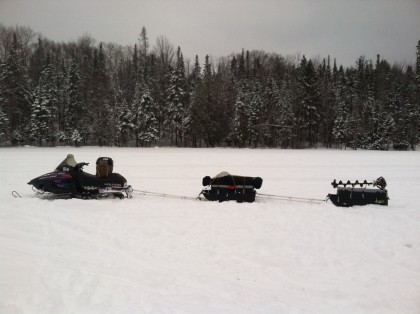
Coldwater species like trout, splake (the DEC Adirondack Hatcheries’ hybridized cross between a lake trout and a brook trout) and landlocked salmon are a favorite gamefish sought by anglers in the park. They are stocked, each spring, in great numbers in many of the more popular lakes in the Adirondacks.
Most ponds and flows that harbor brook trout populations are closed to ice fishing to protect this valuable resource. The very few Adirondack lakes and flows that have brookies and are are open to ice anglers are difficult (but not impossible) to find.
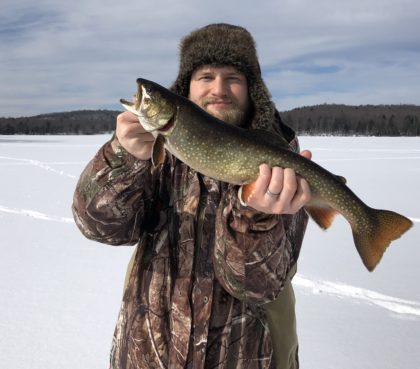
Lake trout are another native char, like the brook trout, that are still populous in Adirondack Lakes. The common belief so many ice anglers have is to fish the deepest water available in a lake when ice fishing for lake trout. This can be counterproductive in the winter months.
Lake trout spend each summer confined to the deepest part of the lake because of temperature and oxygen constraints. When the entire water column throughout the lake is cold, as in early winter, the lake trout take the opportunity to forage in the structure and food-filled shallow water margins of the lake. While your bait is best presented close to the bottom for lake trout through the ice, 20 to 30 feet of water over weeds or near shoals or along ledges and points is a good place to start fishing when the ice is new.
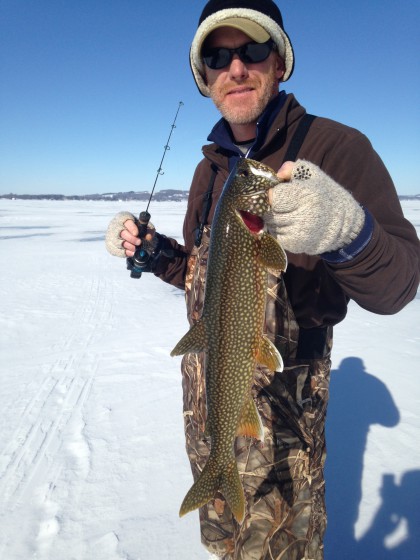
Landlocked salmon and stocked trout, like rainbows and browns, are best ice fished for in the upper parts of the water column. These species will travel up and down in search of a meal. They will root in the bottom for nymphs and larvae and cruise just inches under the ice looking for dying baitfish. Jigging with glow jigs and small spoons tipped with a spike or a minnow head in the center of the column or just a few feet below the ice is effective in lakes and ponds where stock trout exist.
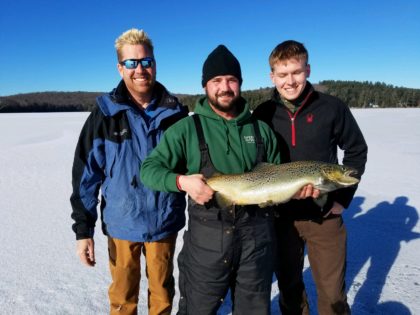
Shallow flows and lakes within the Adirondack Park are great places to ice fish for northern pike and panfish. And most of the “designated” pike water is open for ice fishing. Northern pike are a popular game fish and fishing for them is challenging. As with any large predator fish, an ice anglers success has much to do with the mood and activity level of the fish. Some days they will not feed, while other days they feed incessant.
Large pike, those over ten pounds, are a trophy. And they are common in the Adirondacks, but they are not commonly caught. A fish that grows to a size of ten pounds or more in the large, pressured, lakes and rivers of the Adirondacks, is an educated fish who looks at each meal with caution.
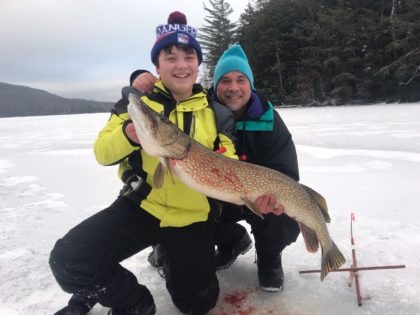
I have come to rely more upon the panfish when taking beginners on the ice for a day of ice fishing in the park. While the quality of the perch and bluegill do not approach the scale found in other parts of Upstate New York, like Central New York or the Finger Lakes, panfish are abundant and reliable. Matched with light line and rods they are fun to catch and delicious eating!
A day on the ice in the Adirondacks is a great way to spend a winters day. Not everyone is a skier! Admiring the winter landscapes of New Yorks’ lake and mountain country, The Adirondack Park, while ice fishing is a relaxing and enjoyable way to get outside in winter!
